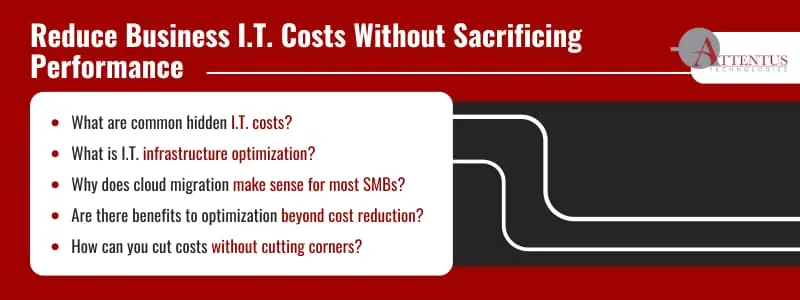You’re probably spending more on I.T. than you should. Here’s how to change that.

How much of your I.T. budget is tied up in hardware that sits idle 80% of the time?
If you’re like most SMBs that haven’t yet optimized their I.T., you’re probably spending more than you should be. Many businesses are only utilizing 15% to 25% of their server capacity as we speak, and they’re burning real dollars that could otherwise fuel critical business initiatives. We want to help you change that.
Let’s take a deeper look at cloud adoption, hardware consolidation, and smarter resource allocation. This article will explore how I.T. infrastructure optimization can reduce business I.T. costs, boost speed, and improve reliability in your environment.
Where are Hidden I.T. Costs Lurking?
Before we get into how you can level up your I.T., it’s important to look at why you’re spending too much in the first place. Three common culprits tend to emerge:
- Unused or underused hardware
- Expensive energy and cooling for legacy servers
- Redundant systems doing the same job
You may have acquired additional servers to meet data storage, processing, and management needs as your business has grown. Each legacy server likely runs a dedicated application and isn’t being fully utilized.
That’s a waste.
These servers also require energy and cooling to run reliably without overheating, plus incur ongoing maintenance costs.
Do you really need all those servers? Probably not.Can you create a leaner server infrastructure without sacrificing performance? Certainly.
Moving away from outdated servers, let’s talk about redundant systems and services.
Some estimates report that the average organization adds six new apps per month, or 91 every year, to its ecosystem. At this rate, chances are you’ll inevitably end up with tools that serve the same function.
Take Dropbox and Zoom, for example. The key functions they provide are already available via your Microsoft 365 subscription.
Eliminating all these elements will reduce your business I.T. costs.
Action item: Perform a quick audit. How many servers do you run, and how many are actually essential to daily operations?
What Does I.T. Infrastructure Optimization Actually Mean?
You don’t actually need more hardware to get your desired output. What you really need are smarter, more efficient systems delivered through a proactive I.T. strategy.
You can optimize your I.T. infrastructure to reduce business I.T. costs through:
- Server consolidation
- Moving key functions to the cloud
- Leveraging centralized management tools
It’s possible to run multiple applications and operating systems on the same server. This is known as server consolidation, and it’s powered through a technology called virtualization. The implications are truly profound.
Let’s say you currently have 10 servers running single applications. Switching to a server that runs even just one more instance could effectively reduce business I.T. costs for hardware, energy, and cooling by half. Yes, that’s 50% savings in all three areas.
Hosting the web applications your teams use daily on the cloud, or moving storage and workloads there, can similarly slash costs. And this doesn’t need to cost you peace of mind. A trusted I.T. provider can guide you on the steps to take to maximize your cloud investment’s value.
Action item: Set a goal. Identify two to three physical systems you can retire or migrate within 90 days.
Cloud Migration Strategy to Reduce Business I.T. Costs, Not Control
Won’t cloud migration mean giving up control? That’s a valid concern, especially for SMBs in highly regulated industries like finance and manufacturing.
Implementing a hybrid cloud migration strategy could be the solution. Here, you can keep the most sensitive assets (such as those with high security and low latency requirements) on-premises and move viable workloads to the cloud.
A cloud migration strategy makes sense for SMBs because:
- The upfront and ongoing costs are low and predictable
- You pay only for what you use
- You can scale resources on demand without much hassle
- Reliable cloud solutions feature built-in disaster recovery, ensuring business continuity
Put differently, a proactive cloud migration strategy gives you the flexibility to run your business on your own terms.
Action item: Prioritize workloads that require 24/7 uptime or experience seasonal spikes, as they’re ideal for the cloud.
Cost Cutting Isn’t Everything
Beyond cutting costs, I.T. infrastructure optimization allows for:
- Faster onboarding for new hires
- Simpler remote access and collaboration for geographically dispersed teams
- Lower carbon footprint from reduced energy use
All considered, optimization is a no-brainer in the next stage of your evolution.
Action item: Use cost savings to reinvest in security, compliance, or business continuity planning.
Reduce Business I.T. Costs Without Cutting Corners
There’s a right and wrong way to reduce business I.T. costs. Taking shortcuts with technology can lead to unnecessary compromises, for example. That’s why we recommend investing in long-term infrastructure strategies rather than short-term fixes.
If you’d like sustainable savings through strategic I.T. infrastructure optimization, Attentus Technologies would love to hear from you. One of our core values is “be the answer” to our clients’ problems. Let us help assess your infrastructure, develop a solid server consolidation, and build cloud migration strategy to reduce business I.T. costs without downtime risks.
Request Your Assessment today
